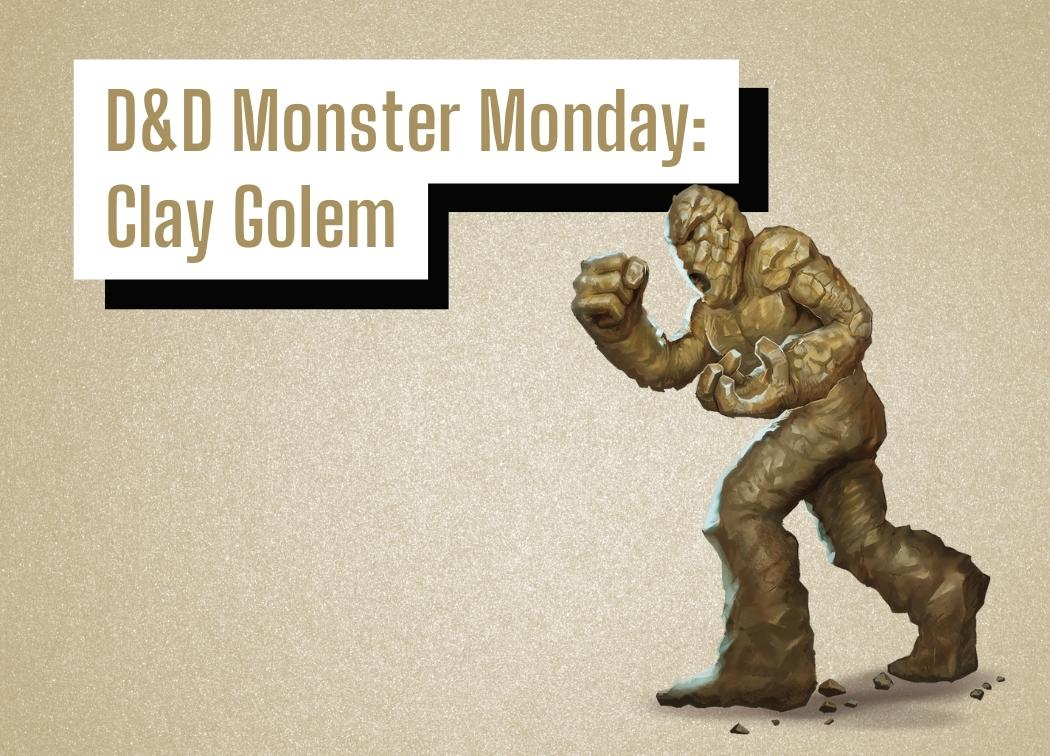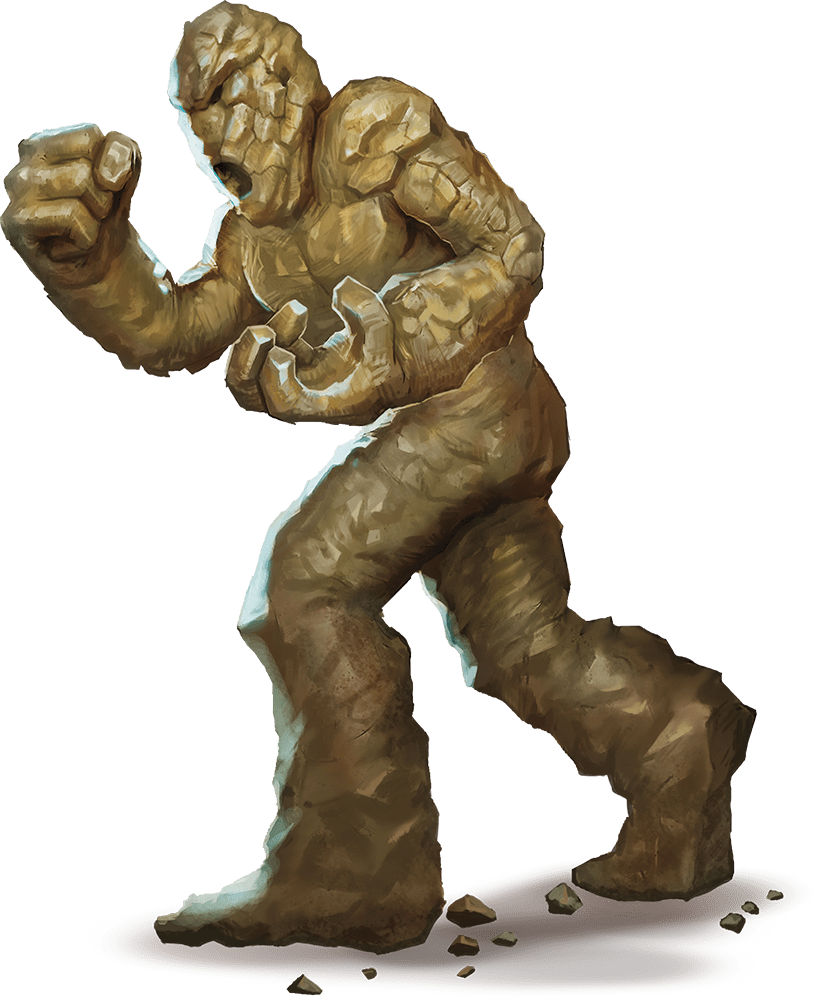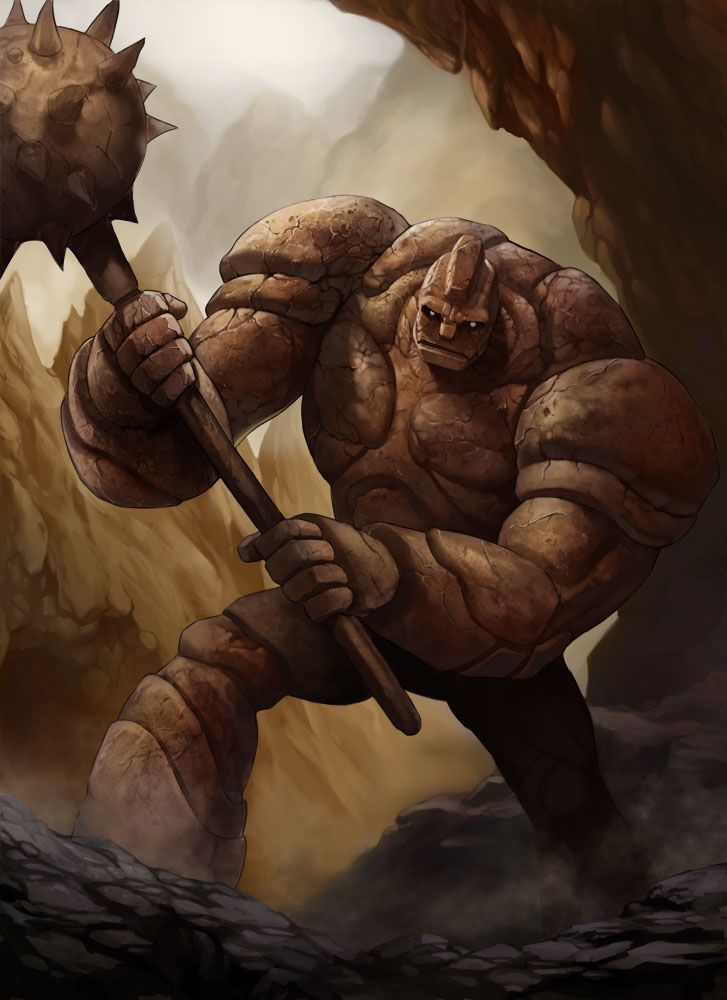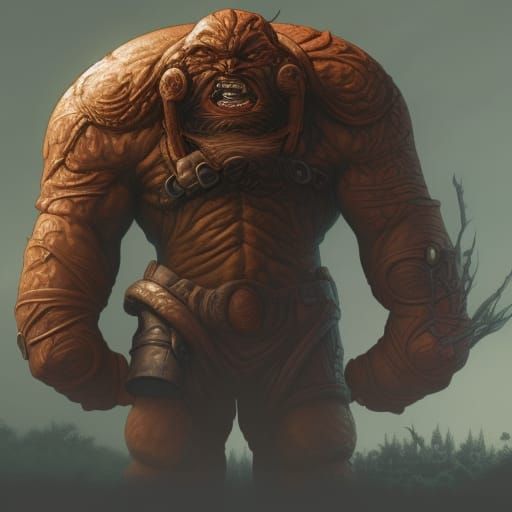D&D Monster Monday: Clay Golem

You’re cornered. This creature, an amalgamation of clay and earth in humanoid form, has absorbed every spell you’ve slung at it and shrugged off every attack you’ve made. The end is nigh as this sluggish clay golem lumbers towards you, its hands curled into fists.
Golems have always had a soft spot in my heart thanks to Diablo 2. It was always an exciting moment getting the next big golem and slotting them into my undead army.
Much like D2, the golems in D&D 5e are pretty diverse in the Monster Manual. Specifically, there are four different kinds of golems in there, each made with unique material. Today I selected what I always circle back to as the “classic” golem, the good, old, clay, golem!
As I was researching and writing this Monster Monday article I saw many similarities between the clay golem and the Nivix Cyclops. Particularly in the niches that they would fill in one of my adventures, the bodyguards/muscle of a powerful magic-user.
Though I must admit, the clay golem has a few disadvantages in their statblock that make them a bit trickier to use. However, if you set these creatures up for success all of that work will be worth the investment.
Take your time, grab a snack. When you’re ready, let’s sluggishly stumble into the Monster Manual and check out the lethargic behemoth, the clay golem!

Clay Golem Lore
As I mentioned before, golems can be made out of practically any material given that their creator has a Manual of Golems. This book contains instructions to construct all different kinds of golems some being costlier and more effective than others.
The critical part of a golem’s creation is binding a soul to the golem’s body. Once the body has been constructed, the creator must fuse a spirit from the Elemental Plane of Earth with the body. This soul has no memory, personality, or any such trait. It simply exists to bring life to the golem.
Golems are, in a way, tethered to their creators. They will do whatever their creator or whoever their creator appoints as a possessor wishes. If they are unable to complete their instructions they may short-circuit and do nothing or possibly go berserk.
Priests or other such divine casters typically create clay golems. Clay is a fragile vessel for a golem, but it is relatively inexpensive and easy to acquire compared to other golem types. Due to their weak vessel, clay golems will often go berserk when they have taken enough damage and their form has been damaged enough to release the soul bound to it.
Clay Golem Stats and Abilities
You can find the clay golem’s statblock on page 168 of the Monster Manual.
Stats
Size: Large construct
Speed: 20 ft.
AC: 14 (natural armor)
HP: 133 (14d10 +56)
STR: 20 (+5)
DEX: 9 (-1)
CON: 18 (+4)
INT: 3 (-4)
WIS: 8 (-1)
CHA: 1 (-5)
While there are some bright spots in this portion of the statblock, the majority of it is pretty awful. Let’s start with the good.
Clay golems are fairly hardy creatures, weighing in at 133 average HP thanks to their 18 Constitution score. They also pack quite a punch thanks to their +5 Strength modifier.
Aaaand that’s it.
This is a creature with well below-average movement speed, four negative ability modifiers (two of which being common saving throw abilities), and mediocre AC. On paper, this is a terrible statblock. Particularly with regards to the 20 ft. of movement per turn as a melee attacker.
Thankfully, the clay golem has tons of immunities, traits, and a unique action that helps to bridge most of the gaps in their statblock.
Resistances, Immunities, Saves, and Skills
Damage Immunities: acid, poison, psychic; bludgeoning, piercing, and slashing from nonmagical attacks that aren’t adamantine
Condition Immunities: charmed, exhaustion, frightened, paralyzed, petrified, poisoned
Senses: darkvision 60 ft., passive Perception 9
Languages: understands the languages of its creator but can’t speak
CR: 9 (5,000 XP)
Look at those damage immunities. They have immunity to two common damage types, one rare damage type, and complete immunity from nonmagical weapons (that aren’t adamantine). That’s a solid spread of damage that is negated without question.
While saving throws should be a significant pain-point for the clay golem, their six condition immunities certainly help to soften the blow. It’s difficult to crowd control this golem by magical means, though grappling or knocking them prone are still valid options.
They’re not very perceptive creatures (who’d have thought), but they at least have darkvision to aid them in guarding dark areas of importance.
CR 9 is a fair assessment. The creature can temporarily hit above this CR thanks to Haste, but Berserk also limits their abilities once they’ve taken enough damage. Most of the clay golem’s power, though, stems from their impressive defenses.
Abilities and Traits
Acid Absorption. Whenever the golem is subjected to acid damage, it takes no damage and instead regains a number of hit points equal to the acid damage dealt.
Berserk. Whenever the golem starts its turn with 60 hit points or fewer, roll a d6. On a 6, the golem goes berserk. On each of its turns while berserk, the golem attacks the nearest creature it can see. If no creature is near enough to move to and attack, the golem attacks an object, with preference for an object smaller than itself. Once the golem goes berserk, it continues to do so until it is destroyed or regains all its hit points.
Immutable Form. The golem is immune to any spell or effect that would alter its form.
Magic Resistance. The golem has advantage on saving throws against spells and other magical effects.
Magic Weapons. The golem’s weapon attacks are magical.
What sucks more than when a creature is immune to your attacks? When it heals off of them, of course! Acid Absorption does just that. If one or more of the party relies on acid type damage a clay golem will have a field day with them. Your mileage may vary with this trait, but when it works, it works.
Berserk is a much-needed “nerf” for the clay golem in combat. Once you hit that 60 HP mark you’ll be at risk every turn for going berserk which effectively takes away the golem’s turn. Keep in mind that this forces the golem to attack the closest creature be it friend or foe. A smart party will use this weakness to their advantage and kite the golem around the room while it smashes its allies and the surrounding area.
Immutable Form is a fantastic way to negate even more crowd control. Spells like Polymorph do not affect a clay golem!
Magic Resistance gives the clay golem a fighting chance at passing the few saving throws it needs to attempt. They’re still stuck with negative modifiers – save for their Strength and Constitution – but they’ll at least have advantage on any saving throws made against spells or magical effects.
Just in case the party has resistance to nonmagical weapon attacks, Magic Weapons has the clay golem’s back. Your punches will strike anything down!
Actions
Multiattack. The golem makes two slam attacks.
Slam. Melee Weapon Attack: +8 to hit, reach 5 ft., one target. Hit: 16 (2d10 + 5) bludgeoning damage. If the target is a creature, it must succeed on a DC 15 Constitution saving throw or have its hit point maximum reduced by an amount equal to the damage taken. The target dies if this attack reduces its hit point maximum to 0. The reduction lasts until removed by the greater restoration spell or other magic.
Haste (Recharge 5–6). Until the end of its next turn, the golem magically gains a +2 bonus to its AC, has advantage on Dexterity saving throws, and can use its slam attack as a bonus action.
The clay golem’s two-attack Multiattack boasts an average action economy value. However, Haste can temporarily boost the golem’s action economy through the roof for a turn or so.
Let’s be honest. A Slam attack is generally a very basic attack that deals a bit of bludgeoning damage. It’s nothing to get excited about when you see it in a creature’s statblock.
However, the clay golem’s Slam includes a DC 15 Constitution saving throw to reduce the target’s maximum HP. This is a brutal effect by itself. Combine this effect with it being a permanent reduction of a target’s max HP until it is removed by restoration magic makes this a huge drain on the party’s resources.
Each time you fail the Constitution saving throw makes you that much more difficult to keep alive until someone can cast Greater Restoration upon you. Best of luck to the party if no one can cast that spell in the middle of the dangerous dungeon.
Haste is a fantastic buff ability. First of all, it takes the clay golem’s AC from “pitiful” to “decent” for a full round. It also boosts your action economy and will let you make three Slam attacks in a single turn once per Haste. It also has a decent recharge rate of 33% so there’s a good chance you’ll be using this more than once per combat.
Clay Golem Strengths
The Best Offense is a Great Defense
5e as a whole favors creatures that can hit hard, even if their defenses are lackluster. Creatures that are defensively-minded generally wind up being mere annoyances. The clay golem is a defensive-minded creature that has the potential to cause some havoc to the party despite its poor offensive abilities.
We’ll touch on how the clay golem is an effective resource sink creature in a bit, but for now, let’s focus on their fantastic defenses.
Sure their 14 AC is not great, but Haste will boost this to a more respectable 16 AC for a whole round at least. With that being said, they have a large health pool that is backed by six separate damage immunities. These are not easy creatures to fell by any means, especially nonmagical ones.
Acid Absorption can even make the situation worse for one of the clay golem’s enemies. Losing your turn due to a creature being immune to your damage sucks, but healing a creature accidentally is even more demoralizing. Especially when it prolongs a fight against a resource sink like a clay golem.

Unable to Be Contained
Indeed, two out of three of the clay golem’s common saving throw abilities are bad, but they at least have Magic Resistance to give them advantage on any saving throws made against spells or magical effects. This gives them a fighting chance to make Wisdom and Dexterity saves and a great chance at passing Constitution saving throws.
They have six total condition immunities which make them difficult targets to crowd control. This also makes their poor ability modifiers less of an issue due to their outright immunity to such a large amount of conditions.
It also helps that they have immunity to the paralyzed and petrified conditions. Both of these conditions would theoretically make kiting the already slow clay golem even easier.
Immutable Form is a great trait. Both in terms of flavor and mechanics as it makes the golem immune to yet another form of crowd control. Spells like Polymorph that change a creature’s form are incapable of effecting the clay golem.
I will concede that even though it’s difficult to crowd control a clay golem, their 20 ft. of movement speed does them no favors. Clay golems are difficult to contain but not to outrun.
An Enormous Resource Sink
I’ll be completely upfront with this. The clay golem’s damage per round is mediocre at best when they are not affected by Haste. It’s solid when it is, but outside of that 1 turn where they get three Slam attacks, they’re not all that great.
What is great, however, is that Slam heavily leans into the clay golem’s identity as a resource sink. Sure, the damage will still force the party to pay the price of healing spells, hit dice, potions, or other such resources. That price is infinitely higher once party members start flubbing the DC 15 Constitution saving throw that’s attached to the attack.
On a failed save, the target’s maximum HP is reduced by their damage taken. Typically when we see this mechanic it’s able to be reverted after a long rest. That is not the case in this instance. You’ll need to expend a Greater Restoration spell or something akin to it.
Until then, fights become considerably more dangerous the lower the party’s max HP is. Healing spells and resources will be used more liberally, draining the party’s supplies quickly.
Yet that’s not the only resource sink that this high HP creature has. Their plethora of condition and damage immunities certainly bolster their survivability. In addition to that, they also have the potential to waste a few of the party’s spell slots and resources as they desperately try to damage and crowd control a clay golem.
Oh, and don’t forget about Immutable Form. That’s a great way to waste a 4th level spell slot from a failed polymorph!
Clay Golem Weaknesses
Berserk + Abysmal Movement Speed = A Bad Time
On paper, these are fantastic creatures with few outright weaknesses. The 20 ft. of movement per turn is problematic, but it can be compensated for at the very least. The same cannot be said regarding Berserk.
At 60 hp, or what is effectively 45% Hp for the clay golem, they have a ~17% chance each round to go berserk. There’s a chance that the clay golem will never go berserk before it is destroyed by the party, but we need to prepare for the worst when we select a creature.
Berserk ensures that you lose practically all control over the clay golem. They will attack the closest creature to them, friend or foe. Not only that but if there is nothing in range or within their pitiful movement speed then they will simply smash small objects and other such items.
This takes all choice away from the creature and can make them more of a liability to your creatures than an ally. Plus, no longer being able to Dash all but ensures that the clay golem will be able to be easily kited around the battlefield.

How to Play a Clay Golem
Best in Confined Spaces
When you are a slow hunk of clay that is only effective in melee range, you don’t want to be subjected to the trials that a large-sized battlefield brings. Let’s face it, you’ll be pegged-down by magical arrows, spells, and other such ranged attacks long before you can make an impact in the battle.
Ideally, you’ll want to place your clay golems in tight spaces, preferably indoors. The more restrictive the environment for the party, the better.
This isn’t difficult to accomplish lore-wise either. Clay golems were purpose-built by divine casters to guard areas of importance. Throwing one in a small church or patrolling the halls near a site of importance is a perfect battlefield for the clay golem.
Keep in mind too that the clay golem doesn’t need to kill the party or die. If it can scare off the party from the place or item it’s guarding then its job is done. Make the party retreat with their tails between their legs and come back with a plan for dealing with this creature.
Excellent High-Level Minion
Assuming that the battlefield was created in mind for the clay golem’s success, the clay golem is a fantastic high-level minion creature. As a resource drain, they will be a constant thorn in the party’s side until they are directly dealt with.
Think of it as a tank drawing aggro in a typical MMO fashion. They’re not the enemy that’s dealing the most damage, but the party is forced to deal with them due to their annoyance.
Couple the clay golem with a magic-user or a few ranged attackers and you have a group that covers each others’ weaknesses and becomes a force to be reckoned with. The clay golem runs interference while the ranged attackers rain hell upon the party.
The clay golem won’t be the focal point in this type of encounter, but honestly, that’s not where their strength lies. They are fantastic minions and resource drainers, use them as such!
5 Clay Golem Plot Hooks
- The Unstoppable Bodyguard – It’s said that the evil wizard’s tower in the swamp holds countless treasures and valuable illegal goods. Many have tried to slay the wizard and take their riches, but none have succeeded. Rumor has it that the wizard has created the perfect bodguard and its track record shows this to be the truth.
- The Church’s Savior – Worshipping illegal gods is a dangerous lifestlye, but their followers have no choice. A quaint temple out in the forest is the only way for these worshipers to be at peace with their gods. Therefore, they scraped together all the coin they could and built a protector to drive out any who would interrupt their peace.
- The Church’s Mistake – Ok, the clay golem was a great idea on paper. I stand by that. I didn’t consider what would happen if it broke and went berserk…
- The Emperor – A mighty ruler has begun replacing their bodyguards, guards, and military forces with golems. This is a costly transition and yet no one knows why they are doing this and what the consequences of this will be. Also… where did all the people go?
- The Wanderer – A clay golem, covered in mold, fungi, and vegetation has been spotted aimlessly wandering the forest. What is this golem’s purpose and who controls it?
Conclusions
All in all, the clay golem is a powerful creature when used in the right environment. They have a couple of limitations in their kit such as their abysmal movement speed, Berserk, and lack of ranged attacks. However, their strengths outweigh their weaknesses when you can utilize them.
The clay golem isn’t a boss creature. It’s best used as a minion or an encounter to soften the party up within the dungeon. Throw these absolute units at the party and have them soak up a bunch of spell slots and other resources!
Your mileage will vary with the clay golem. If the party is comprised of a ton of ranged attackers, they won’t pose nearly as much of a threat. However, a bunch of melee attackers or characters that utilize magic the golem is immune to will have a rough time.
With that being said, there are a bunch of other types of golems in the Monster Manual. Some are more expensive but not nearly as slow as the clay golem. Take a look at them and find the perfect golem to frustrate the party. There’s a golem nemesis for every group!
